When gutters are clogged at blocked downspouts, rain water, left to find its own ay, will pour off the eaves and settle into the ground below, and may then seep into the house. Gutters and down- spouts need at least semiannual inspection, especially in regions that receive large snowfalls. The weight of snow and ice can force a gutter out of alignment or break it away from its supports. And, while many gutters today are made of weather-resistant aluminum and plastic, some are wood or steel, and these re quire inspection for rot or corrosion.
When you are inspecting a gutter, you may need a ladder stabilizer to keep the ladder’s weight off the gutter. Debris in gutters, on screens or downspouts not only slows the water flow, but speeds corrosion. Clear the downspout cage, gutters and gutter screens, if used.
To give momentum to the flowing water, gutters must be canted toward their downspouts. A telltale discoloration will mark any section where the gutter sags and retains a pool of water. Such sags can be mended as shown (bottom right).
While up on the ladder, also inspect for peeling paint, rusted areas, loose hangers or joints, and split downspouts. Small patches of rust can be scraped clean with a wire brush, then coated with gutter cement or an asphalt-aluminum paint. Areas that have rusted badly can be patched with gutter cement and light- gauge aluminum or the defective runs can be replaced. New runs of gutters can be ordered from manufacturers or building-supply stores.
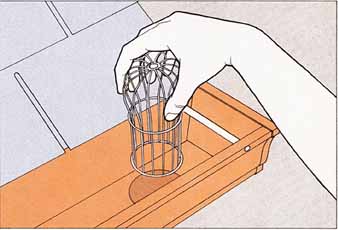
A downspout cage. To prevent downspouts
from clogging with leaves and debris, install a wire cage or strainer.
The strainer will trap leaves while permitting water to flow down the spout.
Periodically inspect the gutter; unless collected debris is cleaned away
from the cage it will mat and impede the water flow.
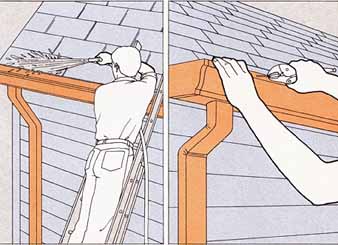
Detecting misalignment. To determine
when a gutter is bent out of alignment, spray water on the roof with a
garden hose (above left). Then watch the flow of water along the gutter;
it will pool in the low spots that need alignment. Realigning gutters.
If the gutter is supported by nails, use vise-grip pliers to twist them
out (above); hammer claws would damage the rim of the gutter. Reposition
the nails or gutter hangers to return the gutter to the proper alignment.
Installing a New Gutter
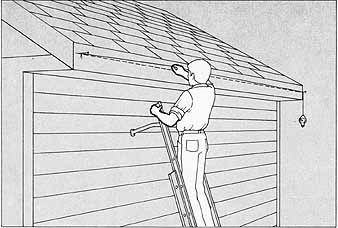
1. Determining the pitch.
String a chalk line between two nails along the intended run of gutter.
A carpenter’s level may be used to check the line. Then determine the amount
of incline needed for the run, using a ratio of 1 inch for every 16 feet, and lower the end of the chalk line near the downspout by that amount.
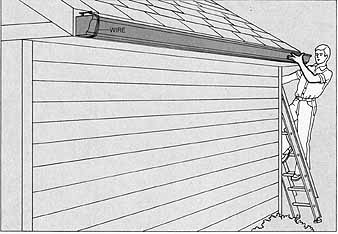
2. Hanging the gutter. Suspend
one end of the gutter from a nail in the fascia board, using a circle of
wire. Begin working at the other end of the run, nailing each hanger along
the chalk line.
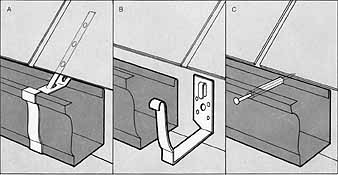
3. The fasteners. Three types
of fasteners are commonly used to suspend gutters: the strap hanger (A),
nailed beneath the lowest strip of shingles on the roof; the fascia clip
(B), which is screwed or nailed directly to the fascia board; and the spike and ferrule (C)—the easiest to install and re align. Drive the spike into
a rafter.